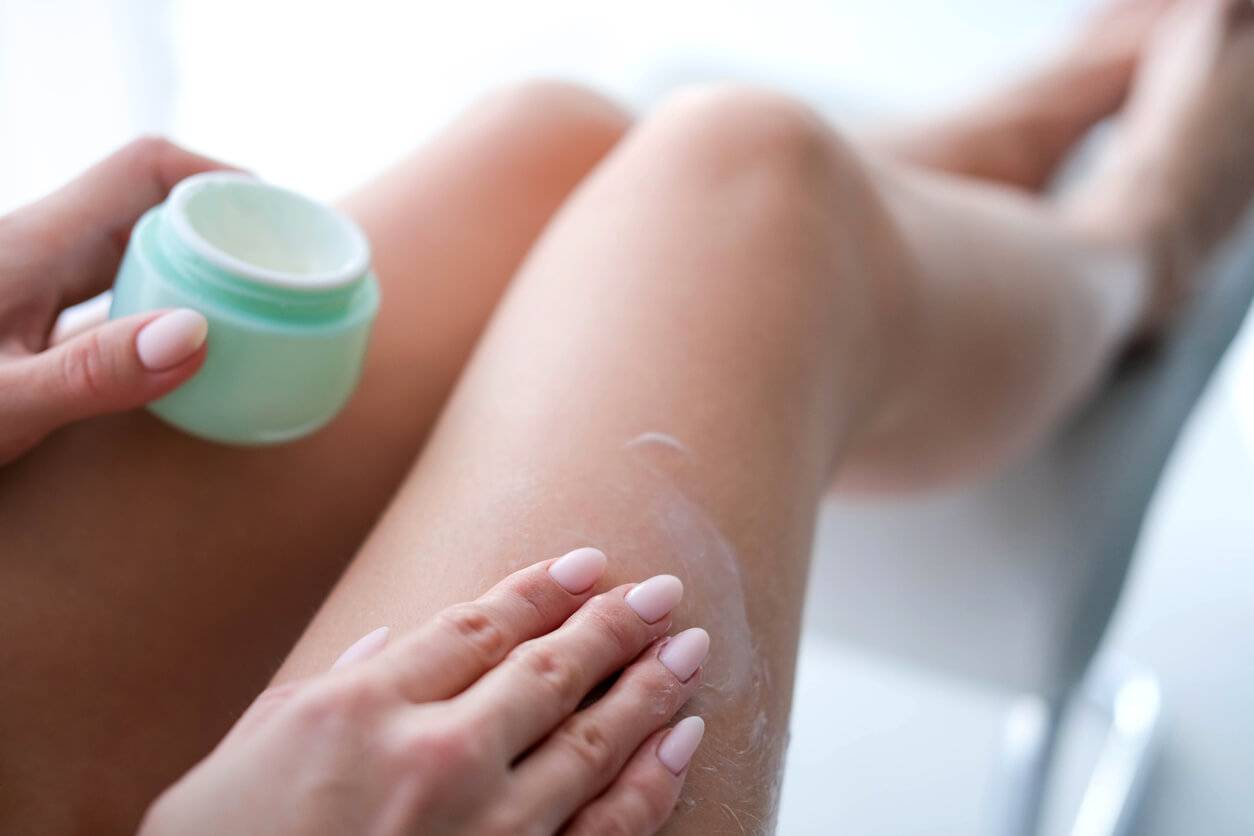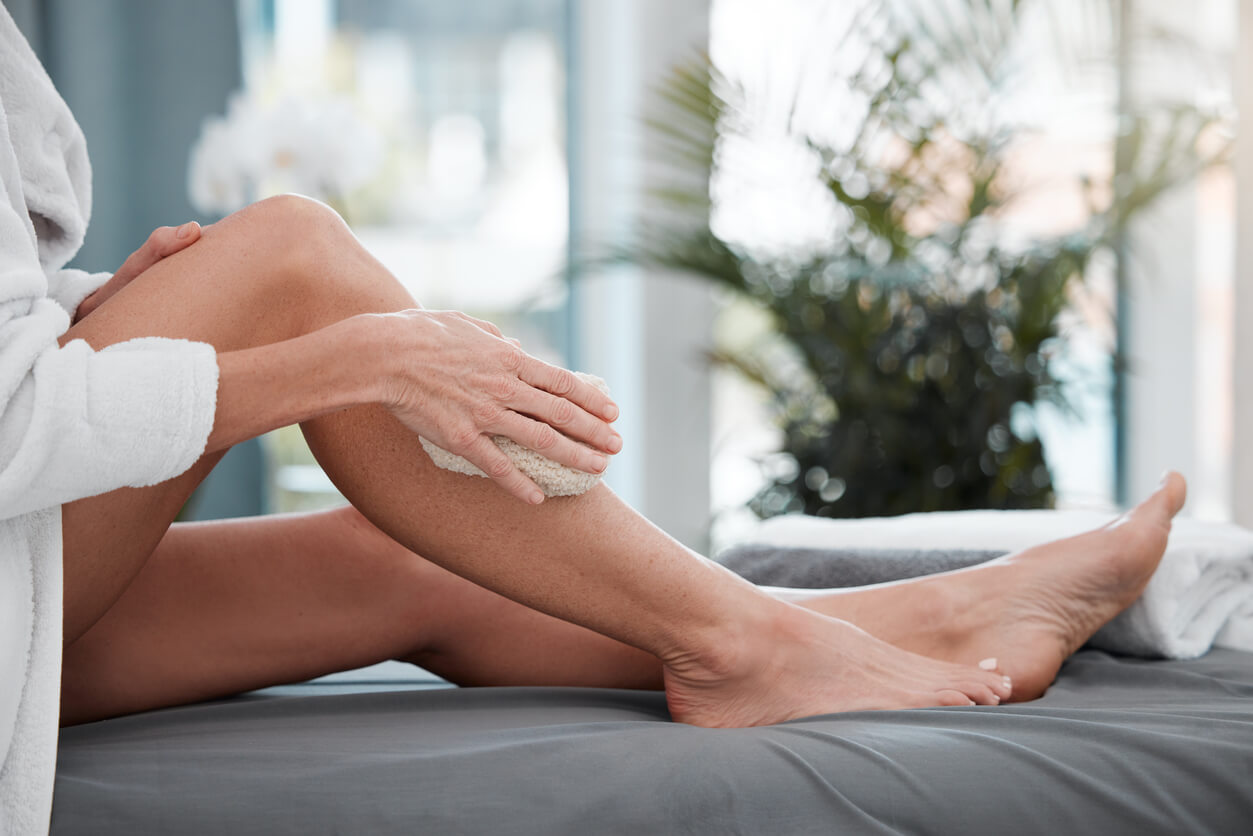A Routine for Postpartum Stretch Marks


Written and verified by the dermatologist Maria del Carmen Hernandez
Although pregnancy is one of the most exciting stages, routines for getting rid of postpartum stretch marks can be overwhelming and time-consuming. It’s best to prevent the development of stretch marks, although this stage can also be the right time to combat and eradicate them.
What are stretch marks?
Pregnancy stretch marks are atrophic linear scars that are manifested by alterations in the connective tissue of the skin. In addition, the presence of stretch marks can cause psychological and emotional distress in many women. In turn, their most frequent location is on the buttocks, abdomen, breasts, thighs, groin, and back.
The early stage is characterized by acute red, flat lesions that are arranged perpendicular to the skin tension. The later stage manifests with wrinkles, atrophy, and hypopigmentation. The ideal time to begin treatment and removal is as soon as they develop, as this is when the skin surface responds most efficiently.
The classification of stretch marks
Stretch marks are a common complaint in doctors’ offices and can be quite distressing. They can also be classified according to their epidemiology or appearance:
- White or red striae
- Striae gravidarum (postpartum stretch marks)
- Striae distensae (stretched skin)
- Striae atrophicans
About 90% of pregnant women may develop stretch marks during pregnancy. This is why it’s essential to plan a routine to combat postpartum stretch marks.
Learn about how to combat postpartum stretch marks
The goal of a postpartum routine is to reduce erythema, edema, and irritation itself. At the same time, the aim is to stimulate the production of elastic fibers and collagen, improve skin hydration, and reduce inflammation.

Moisturizing
Moisturizing to prevent and reduce the appearance of stretch marks is one of the great recommendations. Cocoa butter, vitamin E, elastin, collagen, vitamin A, and hyaluronic acid are some of the components that fulfill the desired effect. Therefore, the application of moisturizers, both with creams and oils, should be done during pregnancy and in the postpartum period.
Sun protection
Tanning and skin protection with adequate sunscreens aren’t therapeutic options. However, constant and correct use of sunscreen is recommended to avoid hyperpigmented lesions in the future.
Exposed skin with stretch marks is more sensitive and delicate than the rest, so it should be treated just like a baby’s skin. In addition, if hyperpigmentation develops in stretch marks, the treatment to eradicate it should be different. It’s best to opt for a sunscreen with SPF greater than 30 and renew its application every two hours in case of exposure to ultraviolet rays.
You may be interested in: Best Methods for Protecting Babies from the Sun
Exfoliation
Microdermabrasion with diamond tips causes mechanical ablation of the skin surface that’s damaged and triggers an inflammatory cascade. Also, the use of different chemical acids at high concentrations can be chosen as an exfoliant, as long as they’re indicated by trained medical personnel.
The use of these chemical agents also induces an inflammatory response with the consequent formation of new collagen. The most commonly used acids are retinoic acid, trichloroacetic acid, and glycolic acid.

Laser therapy
Lasers use light energy on the skin by acting on a specific tissue chromophore. Therefore, they cause an increase in collagen production, decrease vascularization, and increase melanin pigmentation.
According to a review in the American Journal of Clinical Dermatology, combining treatments with lasers and modalities such as topical agents may show promising results. In addition, the use of lasers is linked to erythema, pain, scab generation, and pigmentation alteration.
Topical creams
Topical therapeutic options are often recommended to prevent and treat stretch marks. Tretinoin is one of the most commonly used creams to fade stretch marks. However, they can cause redness, irritation, and flaking. What’s more, their application isn’t recommended during pregnancy.
Topical agents are recommended for red or purplish stretch marks. However, not all topical agents are beneficial for the treatment of both types.
Prevention is the best medicine
Stretch marks, although harmless, are one of the major causes of aesthetic concerns that generate distress in women. The most important thing is always prevention before treatment. Therefore, proper moisturizing of the skin, together with a varied diet during pregnancy, is ideal.
Although pregnancy is one of the most exciting stages, routines for getting rid of postpartum stretch marks can be overwhelming and time-consuming. It’s best to prevent the development of stretch marks, although this stage can also be the right time to combat and eradicate them.
What are stretch marks?
Pregnancy stretch marks are atrophic linear scars that are manifested by alterations in the connective tissue of the skin. In addition, the presence of stretch marks can cause psychological and emotional distress in many women. In turn, their most frequent location is on the buttocks, abdomen, breasts, thighs, groin, and back.
The early stage is characterized by acute red, flat lesions that are arranged perpendicular to the skin tension. The later stage manifests with wrinkles, atrophy, and hypopigmentation. The ideal time to begin treatment and removal is as soon as they develop, as this is when the skin surface responds most efficiently.
The classification of stretch marks
Stretch marks are a common complaint in doctors’ offices and can be quite distressing. They can also be classified according to their epidemiology or appearance:
- White or red striae
- Striae gravidarum (postpartum stretch marks)
- Striae distensae (stretched skin)
- Striae atrophicans
About 90% of pregnant women may develop stretch marks during pregnancy. This is why it’s essential to plan a routine to combat postpartum stretch marks.
Learn about how to combat postpartum stretch marks
The goal of a postpartum routine is to reduce erythema, edema, and irritation itself. At the same time, the aim is to stimulate the production of elastic fibers and collagen, improve skin hydration, and reduce inflammation.

Moisturizing
Moisturizing to prevent and reduce the appearance of stretch marks is one of the great recommendations. Cocoa butter, vitamin E, elastin, collagen, vitamin A, and hyaluronic acid are some of the components that fulfill the desired effect. Therefore, the application of moisturizers, both with creams and oils, should be done during pregnancy and in the postpartum period.
Sun protection
Tanning and skin protection with adequate sunscreens aren’t therapeutic options. However, constant and correct use of sunscreen is recommended to avoid hyperpigmented lesions in the future.
Exposed skin with stretch marks is more sensitive and delicate than the rest, so it should be treated just like a baby’s skin. In addition, if hyperpigmentation develops in stretch marks, the treatment to eradicate it should be different. It’s best to opt for a sunscreen with SPF greater than 30 and renew its application every two hours in case of exposure to ultraviolet rays.
You may be interested in: Best Methods for Protecting Babies from the Sun
Exfoliation
Microdermabrasion with diamond tips causes mechanical ablation of the skin surface that’s damaged and triggers an inflammatory cascade. Also, the use of different chemical acids at high concentrations can be chosen as an exfoliant, as long as they’re indicated by trained medical personnel.
The use of these chemical agents also induces an inflammatory response with the consequent formation of new collagen. The most commonly used acids are retinoic acid, trichloroacetic acid, and glycolic acid.

Laser therapy
Lasers use light energy on the skin by acting on a specific tissue chromophore. Therefore, they cause an increase in collagen production, decrease vascularization, and increase melanin pigmentation.
According to a review in the American Journal of Clinical Dermatology, combining treatments with lasers and modalities such as topical agents may show promising results. In addition, the use of lasers is linked to erythema, pain, scab generation, and pigmentation alteration.
Topical creams
Topical therapeutic options are often recommended to prevent and treat stretch marks. Tretinoin is one of the most commonly used creams to fade stretch marks. However, they can cause redness, irritation, and flaking. What’s more, their application isn’t recommended during pregnancy.
Topical agents are recommended for red or purplish stretch marks. However, not all topical agents are beneficial for the treatment of both types.
Prevention is the best medicine
Stretch marks, although harmless, are one of the major causes of aesthetic concerns that generate distress in women. The most important thing is always prevention before treatment. Therefore, proper moisturizing of the skin, together with a varied diet during pregnancy, is ideal.
All cited sources were thoroughly reviewed by our team to ensure their quality, reliability, currency, and validity. The bibliography of this article was considered reliable and of academic or scientific accuracy.
- Forbat E, Al-Niaimi F. Treatment of striae distensae: An evidence-based approach. J Cosmet Laser Ther. 2019;21(1):49-57. doi: 10.1080/14764172.2017.1418515. Epub 2018 Feb 16. PMID: 29451986.
- Wong RC, Ellis CN. Physiologic skin changes in pregnancy. J Am Acad Dermatol. 1984 Jun;10(6):929-40. doi: 10.1016/s0190-9622(84)80305-9. PMID: 6376552.
- Aldahan AS, Shah VV, Mlacker S, Samarkandy S, Alsaidan M, Nouri K. Laser and Light Treatments for Striae Distensae: A Comprehensive Review of the Literature. Am J Clin Dermatol. 2016 Jun;17(3):239-56. doi: 10.1007/s40257-016-0182-8. PMID: 26923916.
- Ash K, Lord J, Zukowski M, McDaniel DH. Comparison of topical therapy for striae alba (20% glycolic acid/0.05% tretinoin versus 20% glycolic acid/10% L-ascorbic acid). Dermatol Surg. 1998 Aug;24(8):849-56. doi: 10.1111/j.1524-4725.1998.tb04262.x. PMID: 9723049.
This text is provided for informational purposes only and does not replace consultation with a professional. If in doubt, consult your specialist.








